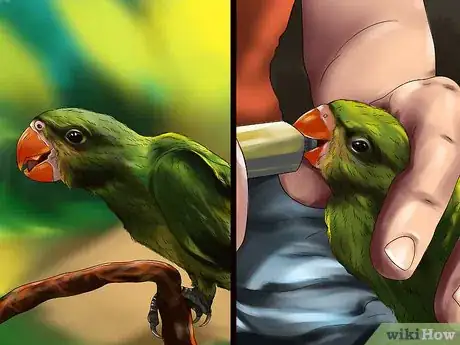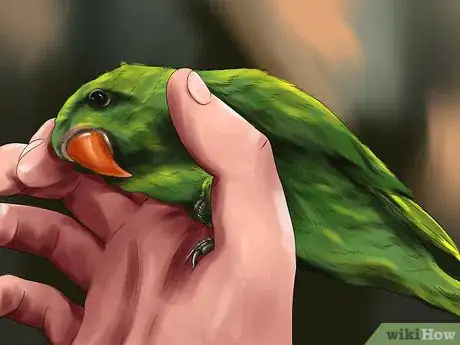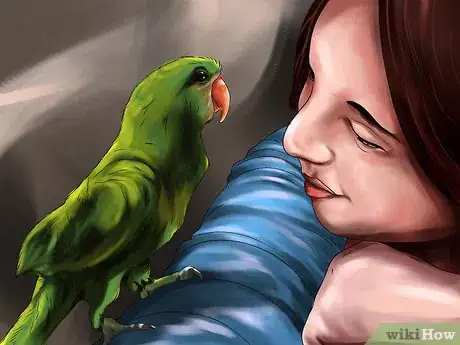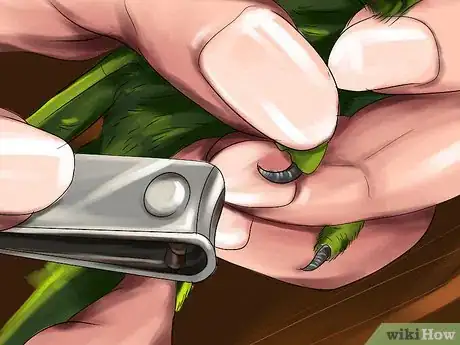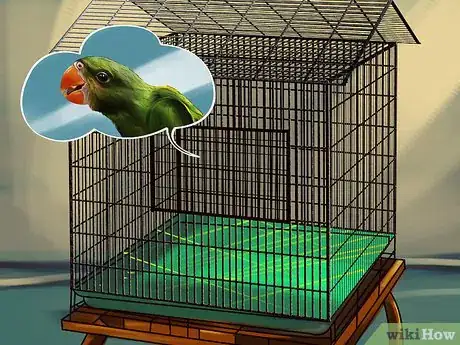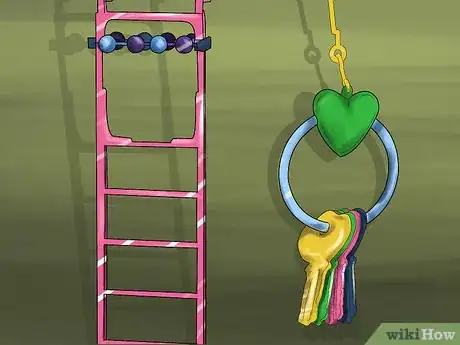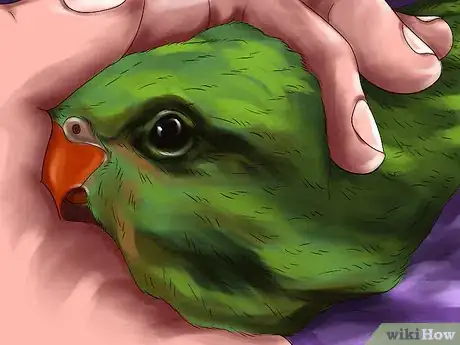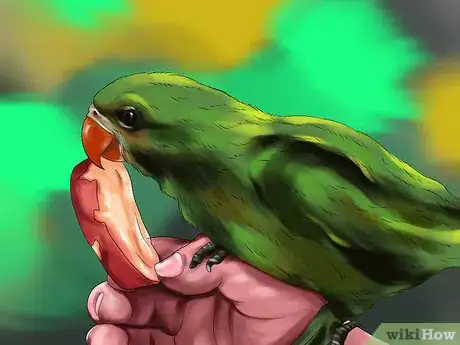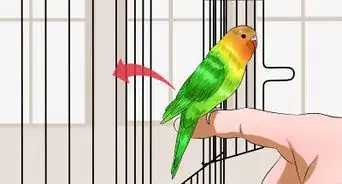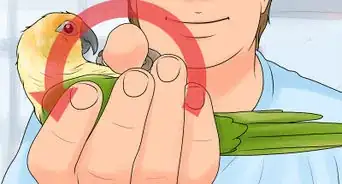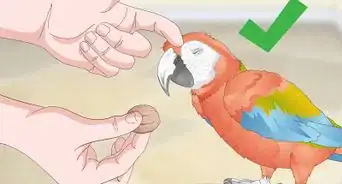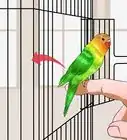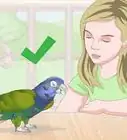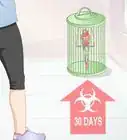This article was co-authored by Pippa Elliott, MRCVS. Dr. Elliott, BVMS, MRCVS is a veterinarian with over 30 years of experience in veterinary surgery and companion animal practice. She graduated from the University of Glasgow in 1987 with a degree in veterinary medicine and surgery. She has worked at the same animal clinic in her hometown for over 20 years.
There are 12 references cited in this article, which can be found at the bottom of the page.
This article has been viewed 41,065 times.
A snuggly bird is a bird that is happy to cuddle up to its human companion and enjoys the company. Raise a snuggly bird by choosing a bird that is ready to interact with you, tending well to its basic needs, teaching it to socialize, and encouraging friendly, cuddly behavior.
Steps
Choosing Your Bird
-
1Get a hand-fed baby bird. Look for a young bird. Baby birds will bond with you most easily. Try to find a bird that was hand-fed by its breeder. This bird will be used to human interaction.[1]
- You can socialize a bird that was not fed by hand. Get the bird while it is still young or buy a bird that has had some socializing with humans.[2]
-
2Choose a bird that you can handle. Consider the size of the bird. Pick a bird that you can carry comfortably. Make sure there is room in your home for a cage that is much bigger than your bird.[3]
- Also assess how much time you can give your bird. Some breeds of birds require a lot more one-on-one time with their humans.
Advertisement -
3Find a bird that will get along with others. Research which birds get along with others, if you live with other people or have other pets. Find a bird that is a good size for children to handle, if you have children. Some species, like lovebirds, may become overprotective of you after bonding and will not share you.[4]
Taking Care of Your Bird
-
1Trim your bird's nails. Keep your bird healthy by trimming its nails. Use clippers made for birds, because scissors can cause injuries if not used properly. Trimming your bird's nails will prevent them from becoming too sharp or uncomfortable when you cuddle.
-
2Make sure the cage is large enough. Buy a cage that is large enough for your bird to fly, climb, and jump. Get a cage that is wide enough for your bird to stretch its wings. Look for a cage that can accommodate perches, some toys, and any retreats that you provide for your bird.[5]
- Get a cage with strong, non-toxic bars that your bird cannot bend or pull apart.
- Be sure to keep its cage clean.
-
3Provide toys. Give your bird toys. Birds enjoy playing and a happy bird will be more affectionate and cuddly. Find toys that are non-toxic and will not be choking hazards, if the bird pulls them apart. Look for toys in the pet store. Consider buying baby toys for your bird, like rattles and blocks.
- Research which toys your bird breed likes best. For example, Quaker Birds love to lace string around the bars of their cages.
Socializing with Your Bird
-
1Bond with your bird. Spend time near the cage, talking to your bird. Put your hand on the cage so it gets used to you. Start to finger train your bird. Use your hands to pet and gently pat your bird.[6]
-
2Handle your bird daily. Take your bird out of its cage every day. Rub it affectionately and nuzzle it with your chin to teach it cuddling behavior. Play with it, hold it, and snuggle it as often as you can.
-
3Teach your bird tricks. Dedicate time to teaching your bird tricks. Shower your bird with attention and reward it as it learns the tricks. Your bird will appreciate this extra time and attention. In return, it will be friendlier and more affectionate.[7]
- Start by teaching your bird to step onto and off of your finger by luring it with treats.
- Next, train your bird to ladder (step up from the finger of one hand to the finger of another).
- Some birds can be trained to talk or imitate sounds.
- Snuggly birds may enjoy training to climb in and out of your pockets and sleeves.
-
4Share food with your bird. Give your bird healthy treats, like fruits and vegetables and eat your own portion of the same food when your bird does. Sit down for a meal with your bird. As flock animals, birds associate sharing food and meals as friendly, social behavior. Cuddle your bird before and after the meal so it associates mealtime with cuddling.[8]
- Only feed your bird foods that it can tolerate at mealtimes.
Keeping Your Bird Cuddly and Happy
-
1Keep your bird's cage open. Give your bird plenty of time out of its cage. Supervise your bird when it is not in the cage, so it stays safe. Provide it with perches in areas where it is allowed to fly and roam. You can also provide toys for your bird to play with outside of its cage. Try getting a play gym so it can exercise. This freedom keeps birds happy. It also give the bird more opportunities to snuggle with you.[9]
- Make sure windows and doors are closed so it does not fly out.
- Keep it away from other pets.
-
2Help with grooming. Provide a bird bath for your bird. Change the water regularly to keep it clean. Take larger tropical birds into the shower or let other birds clean themselves under the faucet. Spray birds with a light mist of water, if they avoid the bath. Birds love bathing and need to groom to stay healthy and happy.[10]
- Bring your bird to the vet if it needs its beak trimmed. This is also essential for your bird's health.
-
3Reward and praise your bird. Keep your bird happy with praise. Praise it for cuddling and being affectionate. Give it treats and cuddle it to reward good behavior. Focus on rewarding good behavior instead of punishing your bird for behaving badly.[11]
- Do not withhold affection. This includes raising your voice, or punishing your bird if your bird does something wrong. Doing these things can make your bird aggressive instead of cuddly.
- Never force a bird to cuddle. Feeling restricted is an alien concept to a bird and may cause it to panic. If the bird shows signs of stress or distress, do not attempt to hold it.[12]
References
- ↑ https://vcahospitals.com/know-your-pet/hand-feeding-baby-birds
- ↑ http://www.parrotparrot.com/articles/breeding-parrots/thought-bird-was-hand-fed/
- ↑ http://animals.mom.me/bird-let-pet-its-belly-9903.html
- ↑ https://www.beautyofbirds.com/lovebirdpets.html
- ↑ https://pethelpful.com/birds/The-Ethics-of-Keeping-Pet-Birds-Caged-Birds
- ↑ http://hari.ca/avian-care/behavior-training/training-budgie-tame-parakeet/
- ↑ https://www.petcha.com/why-you-need-to-socialize-your-bird/
- ↑ http://support.michiganhumane.org/site/PageServer?pagename=vetcare_birds
- ↑ http://www.nationalbirdday.com/a_happy_bird.php
About This Article
To raise a snuggly bird, handle it daily so it gets used to your presence. Additionally, share food with your bird by giving it a piece of fruit or vegetable, then eating your own portion. You should also train your bird tricks, like stepping onto your finger, by luring it with treats. Make sure to praise your bird whenever it behaves nicely, which will help it bond with you. For more tips, like how to trim your bird's nails, keep reading!
